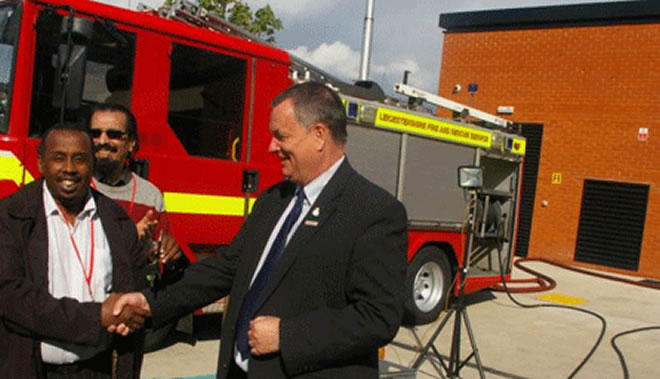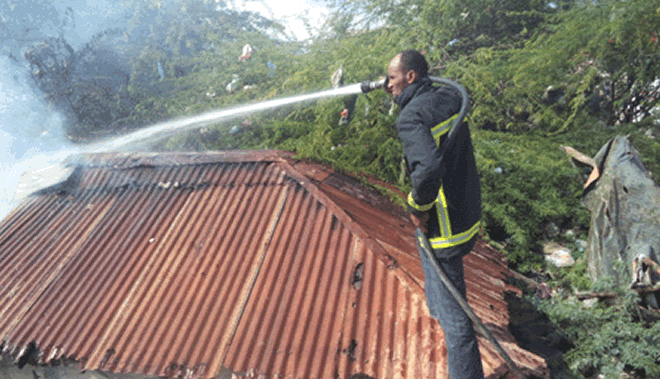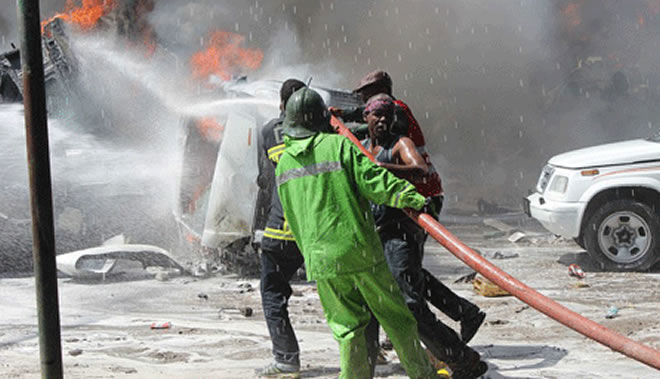
Mr Steve Corrall (right) and Mr Abdulahi Mohamed (left) in Leicester, UK. CORRESPONDENT

Abdulkadir Khalif
Friday, January 17, 2014
On New Year's day at 7:39pm, a call came through for Abdulahi Mohamed, better known as Saneey. There had been a blast in Mogadishu, the troubled capital of Somalia.
Almost immediately his walkie-talkie also begun feverishly transmitting through messages of distress.
"It was about blasts outside Jazeera Palace Hotel near the city’s international airport," Mohamed, who is the Director of Fire and Emergency Services of Mogadishu--the first full fire brigade since the country descended into anarchy two decades ago--said calmly.
Thirteen firemen and three paramedics swung into action, racing to contain the fires from twin suicide bombings at the one of the few luxury hotels in a city ravaged by years of civil war and terror couched in religious fundamentalism.
"I alerted the [commander] on the evening shift about the distress," Mohamed said.
The Bondhere District-based brigade's last mission was last November 28, when fire broke out near Km 4 Roundabout, situated roughly halfway between the presidential palace and the airport.
A functioning fire brigade in Mogadishu would hardly have been conceivable two years ago.
But Mohamed was determined to be part of the post-war reconstruction efforts in Somalia, and a functioning fire services and emergency response department was something Somalia needed badly.
"In 2010, I travelled from Leicester City in Britain to Mogadishu in response to the drought crisis affecting a number of regions in Somalia," Mohamed told Africa Review.
“I was a member of a team of volunteers from IQRA Aid Trust, a UK based charity, helping displaced peoples in Mogadishu."

Fortunate few
Before settling at Checketts Road in Leicester in the UK, Mohamed was among the fortunate enough Somalis who fled the country when war broke out after dictator Siad Barre was deposed in 1991.
But nothing would have prepared him for the homecoming.
"Coming back to the city that I left at the inception of the civil war in 1991 filled my soul with emotion," Mohamed said.
"It was like finding a town that sunk from the 21st century to the 19th century, having lost the meagre facilities it had."
Mohamed says what he found was a city badly in need of emergency response and fire services.
He remembers seeing helpless residents in Hodon, a suburb in the country’s capital, desperately trying to put out a fire using buckets.
"The house kept on burning as helpless residents tried using water buckets to [put out] the inferno.
"I was told that a couple of fire machines belonging to the peacekeepers serving with the African Union Mission in Somalia (Amisom) were the only reliable machines to fight fire in a city of nearly two million inhabitants,” he said.
"Imagine the disproportionate balance of two fire engines for two million city inhabitants? Besides, the Amisom machines (fire trucks) were not easily available as they were stationed at Mogadishu’s Aden Abdulle International Airport, t[therefore] not helping the situation very much."
Casualties of war
The virtually non-existent emergency response services forced residents in the capital to regularly use wheelbarrows to deliver casualties of the long-running Al-Shabaab insurgency to hospitals.
A vehicle would cost about $20 to $50 to hire – an amount many could not afford. Mohamed realised his city, which he had called home as a child, badly needed fully equipped ambulances with trained paramedics to provide emergency medical care for war victims in Mogadishu.
He immediately contacted the Mayor of Mogadishu, Mohamed Ahmed Nur, and pitched to him his vision of providing emergency response and fire services for the city, a shift from his job in relief services. The two men agreed to team up and implement the project as a joint public-private initiative.
Back in the United Kingdom, Mohamed earnestly began fundraising to buy fire trucks and ambulances for Mogadishu.

Firefighters in action in Mogadishu. ABDULKADIR KHALIF
"Through IQRA Aid Trust, we used to send teenagers to the streets of Leicester to collect donations for the purpose,” Mohamed said.
In February 2011, Mayor Nur was in the UK, where he received three ambulances and a fire truck donated by IQRA Aid Trust.
More funding was raised through donations from other British cities, and soon enough money was raised to ship the vehicles from London to Mogadishu.
Crash course
In order to effectively implement the project, Mohamed had to enrol for a crash course in emergency planning and fire fighting in Leicester.
He returned to Mogadishu in November 2012 and recruited a group of young people as apprentices, training them at Banadir Regional Authority Headquarters among other sites.
Follow up training took place in January 2013 at Mogadishu Stadium under the auspices of Amisom peacekeepers, with 16 of the trainees graduating.
The city has since procured more fire trucks. "Two more engines were bought by Mogadishu’s Municipality, increasing the number of vehicles to three," the city Mayor said.
"In August last year, Leicester offered a fire engine, which upon delivery to Mogadishu will take the total to four fire fighting engines," Mohamed chimed in.
The chair of the Combined Fire Authority in Leicestershire, Mr Steve Corrall, handed Mohamed the keys of the fourth truck in September last year at the Leicestershire Fire and Rescue Service Headquarters.
A report released by Mogadishu’s fire and emergency services in December said the unit has responded to 78 fire incidents and 137 ambulance calls since December 2012.
The unit has responded to emergency calls from homes, community centres, schools, hotels, and even including the country’s main airport and the Turkish embassy when some of their bullet-proof vehicles caught fire.
One woman is grateful that Mogadishu had a functioning fire service unit when her pharmacy in north Mogadishu caught fire: "The service saved $15,000 in cash that was in my safe."
Mr Mohamed says that on-site experience combined with special training is helping his fire fighters and paramedics gain more knowledge. Twenty of them have been sent to Kenya for more specialised training.
The training, funded by the UN Support Office for Amisom, took place at Nairobi’s Jomo Kenyatta International Airport. In May, they will take courses in emergency planning and response involving sea and air ports.
Providing emergency services in perhaps the world’s insecure city is not a walk in the park.
Loud sirens and bright lights
"Widespread lack of awareness of the fire and emergency service’s importance hinder our efforts," Mohamed said. Motorists have no idea what is the deal behind the loud sirens and bright lights, and they just don’t give way to ambulances and fire truck, putting lives and properties at risk.
In a business where a second is the difference between life and death or a standing building and a razed one, police officers have no qualms regularly stopping ambulances and fire trucks for security checks – leading to desperate delays.
The city road network is also deplorable, meaning that many areas cannot be reached by road.
"Rather than taking the usual five minutes, a journey takes 15 minutes as we are forced to detour to avoid potholed and bumpy roads."
Mogadishu’s sewerage services hardly work. This means buildings in the city have dug out their own septic tanks at their front yards, placing the fire trucks at the risk of ending in these tanks, which can be several meter's deep.
Water also remains a major challenge in the capital: "[There is] no hydro-system or continuous flow of water through publically available pipes for the fire fighters to connect and use during emergencies," he said.
The 60-strong fire fighting unit--all male--holds weekly meetings every Thursday to review progress and setbacks, highlight strengths and weaknesses, and commend the best performing team.
The fire fighters and paramedics regularly undergo training on literacy and numeracy skills. English is highly encouraged by the management as the manuals and drills are in the language.
In November, the brigade secured the number 555 for fire and emergency services.
"We agreed with the telecommunications companies on the exclusive use of phone number 555, but we are going to let the public use it as soon as we set up the system, properly."
While I was getting ready to wind up the interview, the director received a distress call about four kilometres down the street.
The team on duty clambered onto three fire trucks and rushed off to the scène.
"By January 2014, we are going to provide UK standard dress, footwear and fire extinguishers," said Mohamed.
"For close to 25 years, this city had no fire brigade," Mayor Bur added. “We are going to build a dependable fire and emergency response system, no matter what it costs us.”